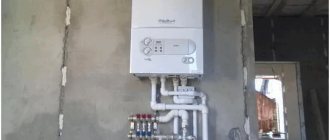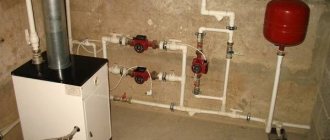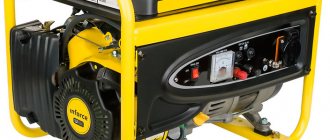Features of gas heating
Despite the presence of a large number of alternatives (electricity, diesel, diesel, fuel oil, firewood, coal), gas heating is still the leader in the world. And there are serious reasons for this:
- Economical. Compared to other options, gas is relatively cheap and has high efficiency. In this case, not only the cost of the fuel itself is taken into account, but also additional expenses for its storage (for the consumer), maintenance of the entire system, etc. Thus, parts for rare types of boilers can be difficult to obtain, and sometimes you have to overpay. This is also taken into account.
- Minimal human involvement. Heating a room using wood or coal requires mechanical addition of fuel. Here everything is automated, including gas supply and flame control.
- Cleanliness, absence of soot, soot and other things. Boilers can be easily installed in the kitchen.
- Possibility of heating large rooms. One powerful boiler can handle a building with several floors.
At the same time, gas heating also has its disadvantages. Or rather, specificity.
Installation should only be carried out by specialists Source nehomesdeaf.org
In particular, the installation of a boiler requires approval from Gaztekhnadzor. Installation can only be entrusted to an organization with a license giving the right to provide such services.
Do not forget that gas is explosive. Therefore, saving on automation is extremely undesirable: it monitors, among other things, its leakage (we are talking about modern technology).
In addition, you need to take care of ventilation. Combustion products can be removed from the building naturally. But if problems arise with draft, you need to change the installation location of the boiler (which is not always possible) or provide it forcibly.
Gas boilers for heating a private house: what are they?
There are many different boilers on the market now. And you need to figure out how one type differs from another for the consumer. This makes it easier to understand what to choose - a floor-standing gas boiler for heating a private home, or a wall-mounted one, and with what functions, so as not to make a mistake. Otherwise, you will either have to endure inconvenience or spend extra money.
Single and double circuit boilers
One of the main classification methods is the division into single- and double-circuit boilers. The latter heat water not only for the heating system, but also for domestic needs. That is, there is no need to install an additional boiler.
The difference between single and double circuit boilers Source remstrdom.ru
In a word, double-circuit gas boilers for heating a house are designed in such a way that they receive cold water from the central water supply system. Then the liquid heats up. In addition, the design has a special valve. It regulates where the hot water will be supplied. If you don’t wash anything or run a bath, the boiler works to provide the heating system. But as soon as the tap opens, the valve closes the device. And water begins to flow to people.
See also: Catalog of companies that specialize in home insulation.
Consider another important point: in order to be able to take a bath rather than a contrast shower, you need a boiler with a capacity of at least 28 kW. The exact figures depend on the size of the heated premises and the number of consumers. Roughly speaking, the more people need to wash, for example, the higher the load. And the more powerful the heater should be.
Video description
You can see the difference between single- and double-circuit boilers in the video:
Is it possible to use single-circuit boilers to heat water for domestic needs? Yes, many modern models allow this. But you'll have to buy a boiler. It needs to be connected to the boiler, and in any case, the entire process, starting with the selection of a suitable model, should be entrusted to a specialist. Most consumers, however, in such situations usually simply take a separate boiler that runs on electricity.
For example, to quickly connect a boiler, you can pay attention to the Boilerplect module from GIBAX. It is used to connect electric storage vertical and horizontal water heaters with a connection diameter of 1/2″ to the water supply system. It has a mode for disconnecting the water heater from the water supply system, and a mode for draining water with air suction for carrying out maintenance work.
An example of a combination of a heating boiler and an indirect heating boiler Source nehomesdeaf.org
Which option is better? Mostly they prefer double-circuit boilers: they are more convenient. But keep in mind that such models are always more expensive. The choice, in any case, depends on consumers.
Floor and wall boilers
Boilers can also differ in location in space: there are gas floor- and wall-mounted heating boilers for private homes. The latter take up less space and are generally more compact. In addition, they can be installed almost anywhere if certain requirements are met. Also, for wall-mounted boilers there is no need to organize a separate chimney: usually everything is solved through a pipe through which combustion products are removed.
What is the difference between floor-standing gas boilers for heating a house (that’s what they are officially called)? They are usually more powerful and noticeably heavier. Such models require more space: firstly, for the lining, and secondly, for the chimney. And this is not to mention the set consisting of a single-circuit boiler and a boiler. In addition, such units are quite noisy, so they are usually installed in a separate room (boiler room).
Most often, a boiler room is installed in the basement or basement Source makemone.ru
The choice of the optimal solution depends on what exactly you need in a particular case. That is, for an apartment or small cottage, the best gas boiler for heating is a wall-mounted one. For a large house - floor-mounted.
But when purchasing, you need to take into account one more factor that can become critical: dependence on electricity. Floor-standing boilers work stably in this regard. Even if there is no electricity in the house, the heat will still remain. True, now more and more models are being produced with automation, which removes this advantage. Nevertheless, options can be found.
But all floor-standing models depend on voltage: surges in the network can damage the equipment. Of course, no one bothers to install a stabilizer. But, firstly, this is an increase in costs. Secondly, the issue of power outages remains.
In general, both floor and wall products have their own advantages and disadvantages. Therefore, figuring out how to choose a gas boiler for a private home depends on the specific premises, the quality of the electrical network and financial capabilities.
What is a gas boiler?
Gas boilers for a private home are a device that provides uniform heating of a residential area. Natural gas is used for heating. During the combustion of this substance, thermal energy is released.
Modern models of heating equipment have many options that allow you to choose the rate of heat supply to the room and reduce the volume of raw materials consumed.
The basic principle of operation of a gas boiler is that fuel is supplied to the electric ignition device. When the ignition is started, a spark is produced that ignites the igniter. If it is missing, the gas supply is blocked.
An automatic safety system blocks the leakage of raw materials and prevents the accumulation of flammable material indoors.
How to choose a boiler for heating a private house
When choosing a gas boiler, you need to consider not only what they come in. There are many more important parameters. Let's figure out what you should pay attention to.
How to choose a gas boiler for a private house by power
It should be noted that it is very important to calculate the appropriate power, that is, no less and no more. With the first, everything is clear: the building simply will not warm up sufficiently. But why is it undesirable for the boiler to be more powerful? In this case, the heating system begins to operate unevenly, which leads to excessive wear. The result is frequent repairs and premature replacement of the boiler. In addition, gas consumption increases.
Video description
Visually about choosing power in the video:
So, how to make the calculation? In general, it is best to contact experienced specialists with this. The fact is that when calculating, you need to take into account a huge number of different factors:
- number of floors;
- ceiling height;
- the presence or absence of thermal insulation, as well as its type;
- year the house was built;
- wall material;
- selected method of water heating;
- climate zone.
And that's not all! It also matters whether the boiler is selected for townhouses or for ordinary houses (the former are usually warmer, although there are plenty of nuances here too). The calculation is also affected by the presence of other heating sources in the building, for example, heated floors. In addition, an experienced specialist always clarifies what the average room temperature should be. After all, there is a big difference between + 15 and + 23 degrees Celsius.
You can make an approximate calculation like this: you need to multiply the area of the house by the climate zone indicator, and divide the resulting amount by 10. This option is suitable for standard buildings with a ceiling height of up to 3 meters.
Let's say the building is located in the northern regions of Russia. There the climate coefficient is 2 kW. Therefore, the boiler must have a power of 20 kW. But for a double-circuit one, this figure must be multiplied by ¼. That is, the result is 25 kW. And remember that he is exemplary!
For an initial assessment of power, you can use the table Source tarifi.info
Which boiler is best for a private home: the issue of the chimney
Boilers with an open combustion chamber, as a rule, do not have a chimney. But in this case, it is necessary to ensure the removal of combustion products. And keep in mind that some part may still get into the air in the room. Therefore, for the safety of people, it is best to install such boilers in a separate room.
If we are talking about a closed chamber, then forced draft is created there. And since the size and cross-section of the chimney do not affect the passage of air flow (blowing depends on the fan), installation is carried out using a coaxial pipe. It is easy to install and has a small diameter.
Turbine boilers are another option that is popular. Here the air flow is provided by a special fan. Combustion products are discharged directly to the street. Moreover, the hole is usually small (it is visible from the outside).
When choosing this model, you can refuse to organize a chimney. But turbine structures need to be cleaned from time to time: if the entrance becomes clogged with leaves, for example, the boiler will stop working.
Ventilation of a turbine boiler Source spetsotoplenie.ru
Each solution has its own advantages and disadvantages. But remember: only models with natural draft are considered non-volatile! So if electricity is often cut off in your locality or area, then the only option would be products with natural draft and without a chimney.
Basic criteria for choosing a boiler
When choosing a boiler with an atmospheric gas burner, you need to pay attention to the following main characteristics:
- Power;
- Number of circuits;
- Installation method: floor-mounted or wall-mounted;
- The material from which the heat exchanger is made;
- Automation and security
Let us dwell on each of the criteria in more detail, and consider all the main points associated with the given technical characteristics, with the exception of those that have already been discussed above.
Heating unit power
The quality of heating and the creation of a comfortable temperature in the room largely depend on the power of the boiler.
When calculating the boiler power, you need to take into account:
- Room area;
- Room volume;
- Thermal conductivity coefficient of walls, windows and doors.
In order not to dive deeply into numbers and calculations, you can take another, simpler route. It is generally accepted that to heat 10 square meters of housing, 1 kW of boiler power is sufficient for standard ceilings with a height of 2.5 m and insulation of the room. Thus, it is enough to divide the area of the room by 10, and we obtain the theoretically required boiler power.
The resulting figure must be increased by 20% to ensure normal operation of the boiler during peak load periods. To obtain a sufficient volume of hot water, which is especially important for flow-through double-circuit boilers, the power must be increased by 25%.
Material for the manufacture of heat exchanger
The main materials from which the heat exchanger of an atmospheric boiler is made are cast iron, steel, stainless steel and copper. A cast iron heat exchanger has almost no power limitations. It is reliable and durable, thanks to its excellent anti-corrosion properties.
But this also has its own characteristics - cast iron can crack due to the temperature difference at the point of water entry and the heating zone. Design solutions include the prevention of low temperature corrosion by installing a four-way valve.
Cast iron heat exchangers are installed in floor-standing boilers. The products are large in size and weight.
The cast iron heat exchanger has no restrictions on boiler power and is the most reliable and durable
Steel heat exchangers are used by domestic boiler manufacturers due to their low cost. Such heat exchangers do not require installation, they withstand thermal loads well, but at the same time they are significantly inferior to cast iron heat exchangers due to their low corrosion resistance.
A good alternative to steel is a stainless steel heat exchanger. It combines all the positive qualities of steel and cast iron - it is durable, immune to thermal shock, and has high corrosion resistance. But at the same time, boilers with stainless steel heat exchangers are more expensive.
Copper is flexible and conducts heat well. Heat exchangers made from it have many fins and are characterized by a small volume, due to which it is possible to reduce the size and weight of the boiler.
Copper heat exchangers are used in wall-mounted boilers, providing quick heating, which reduces fuel consumption. Due to its compact size and small amount of water, a circulation pump is required to avoid boiling.
Automation and security
Automation ensures safe operation of the boiler, economical fuel consumption, and helps increase the level of comfort when operating the equipment. The cost of automation for a gas boiler is determined by the number and complexity of programs and functions.
Some of them are considered basic and should be present in any gas boiler. They are responsible for preventing gas leaks as a result of various non-standard situations - flame extinction, drop in gas pressure.
There are two types of automation – volatile and non-volatile. The first is considered the most reliable, but requires a connection to the mains and an uninterruptible power supply. The second is considered mechanical, it is simpler and is autonomous.
Non-volatile automation system
It is characterized by autonomy, high maintainability and low price. The temperature range of the thermostat is selected manually using a thermostat, which has a rod in its design that lengthens or shortens depending on the temperature. As a result, the gas supply valve opens and closes.
We recommend: Flushing the heat exchanger of a gas boiler: the most detailed instructions for doing it yourself, choosing liquids and other means for descaling, the cost of equipment and specialist services
Non-volatile automation is easy to operate and ensures the operation of basic security systems
The basic automation package includes draft and flame sensors. When the draft decreases or the burner goes out, the gas supply is blocked. Although non-volatile automation is considered simple and reliable, it does not make it possible to operate the boiler in optimal modes, which reduces the service life of the equipment.
Volatile device version
Operating parameters or operating modes are entered on the display or from the remote control, after which the control and regulation systems are launched.
Energy-dependent automation extends the service life of equipment and opens up opportunities for wide comfort control functionality
The principle of its operation is based on the operation of solenoid valves, which are controlled by a microprocessor unit.
Main functions of modern automation:
- Temperature maintenance for a certain time;
- Adjustment of thermal conditions depending on the weather;
- Electronic flame modulation;
- Protection of the heat exchanger from overheating;
- System frost protection;
- Protection against jamming of the circulation pump;
- Self-diagnosis.
The disadvantage of the system is its energy dependence; in the absence of electricity, the equipment is blocked. To ensure full operation, the automation must be connected to an uninterruptible power supply.
Video description
Additional information to consider about choosing a gas boiler in the video:
From domestic manufacturers it follows about. The company's boilers are universal, suitable for most heating systems. Manufactured from high-strength steel. Many people are also well aware of the Zhukovsky boilers. Produced in the Moscow region, they attract with a surprisingly affordable price and simple design.
It is difficult to say which option is better here. Much depends on what exactly you are counting on.
Which gas boiler is better to choose for heating a private house: price
Prices for boilers, in terms of American dollars, start around 250 dollars and reach up to several thousand. Moreover, this amount does not always include delivery, and installation in most cases is paid separately.
In general, a double-circuit boiler is more expensive. But if you compare it not with a single-circuit one, but with a set of a boiler and a boiler, then the calculations are no longer so clear-cut. You will have to spend more money on the option with a chimney. And the most affordable one is a floor-mounted single-circuit boiler with natural draft of domestic production.
Single-circuit floor-standing boiler Source etechzone.ru
True, paying less for a product does not mean that the issue of saving is finally resolved, because if in a few years you have to undergo serious repairs or a complete replacement, then the benefit is frankly dubious. Therefore, it is not advisable to focus solely on the issue of price when purchasing a boiler.
The gas boiler is the heart of the heating system. It largely determines whether your house (or apartment) will warm up normally, how much you will have to pay every month for utilities, whether there will be a problem with dampness, etc. Therefore, when buying a gas boiler, there is no need to rush. Moreover, there are many types of gas heating boilers on the market for a private home - for every taste and budget. This means you have the opportunity to choose the truly optimal option. We have looked at the main criteria for choosing a boiler for heating a private home, and we hope that you will not have any problems when choosing this important equipment.
Ratings 0
The best floor-standing atmospheric boilers
This segment presents samples of domestic production, Italian and German series.
BaxiSlimEF1.22
The power of the device is 22 kW, the device is optimal for heating an area of up to 200 m², dimensions 850x400x595, sold at a price of 52,000 rubles.
BaxiSlimEF1.61
Model with a power of 60.7 kW, heated area up to 580 m², dimensions 850x400x870, cost within 84,000 rubles.
TitanN30E
Single-circuit non-volatile device with a power of 24 kW, heated area up to 280 m², dimensions 940x295x570, cost varies between 38,000-40,000 rubles.
TitanZ30E
Domestic floor-standing gas installations of the TitanZ series are designed to service autonomous systems with coolant pressure up to 0.3 MPa. The TitanZ30E model with a power of 22 kW of single-circuit design is capable of heating an area of up to 220 m², unit dimensions are 940x295x570, the products are sold at a price of 39,500-41,900 rubles.
RodaKrafterEvoRmod30
The model is single-circuit, belongs to the list of top sellers in 2021. The power of the unit is 31.2 kW, the potential of the heating device is designed to serve an area of up to 300 m², the heat exchanger is cast iron sectional, dimensions 910x450x475, cost from 61,000 rubles.
RodaKrafterEvoRmod60
A new modification of the device with a power of 60.5 kW, a single-circuit model with a sectional cast-iron heat exchanger, is capable of heating an area of up to 550 m². Dimensions 910x450x700, product cost from 83,000 rubles.











